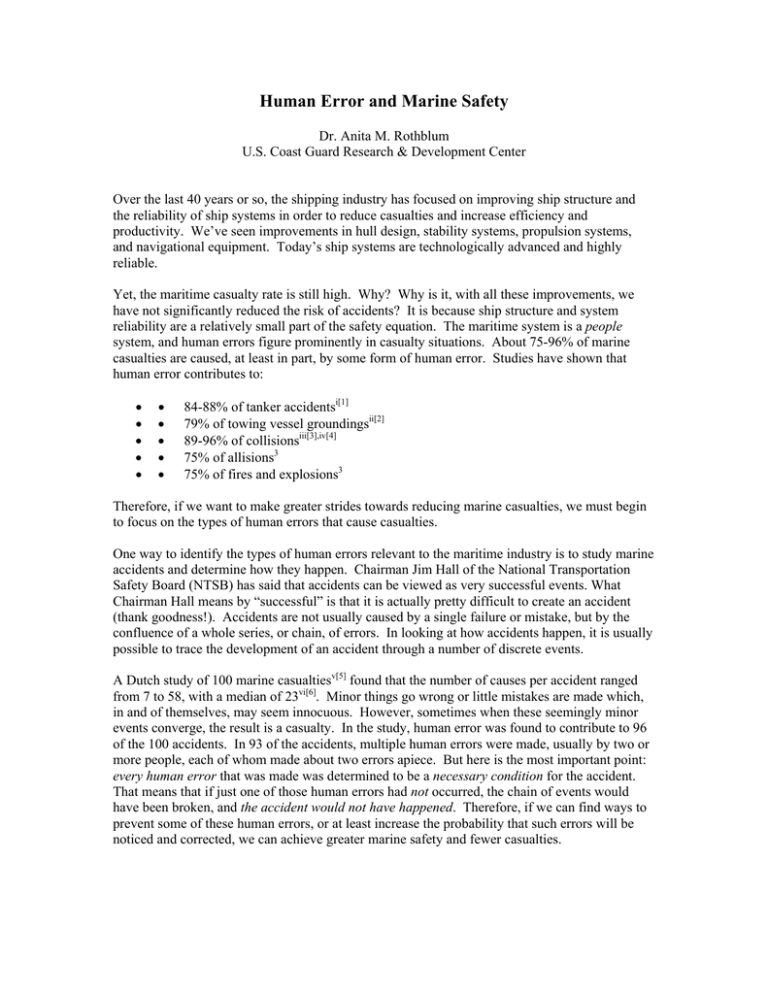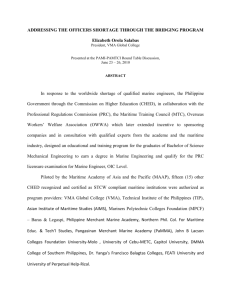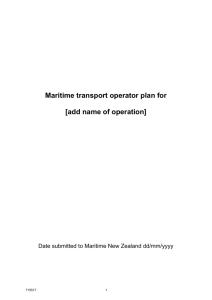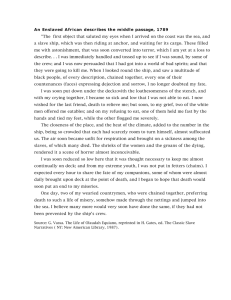Human Error and Marine Safety - Bowles
advertisement

Human Error and Marine Safety Dr. Anita M. Rothblum U.S. Coast Guard Research & Development Center Over the last 40 years or so, the shipping industry has focused on improving ship structure and the reliability of ship systems in order to reduce casualties and increase efficiency and productivity. We’ve seen improvements in hull design, stability systems, propulsion systems, and navigational equipment. Today’s ship systems are technologically advanced and highly reliable. Yet, the maritime casualty rate is still high. Why? Why is it, with all these improvements, we have not significantly reduced the risk of accidents? It is because ship structure and system reliability are a relatively small part of the safety equation. The maritime system is a people system, and human errors figure prominently in casualty situations. About 75-96% of marine casualties are caused, at least in part, by some form of human error. Studies have shown that human error contributes to: • • • • • • • • • • 84-88% of tanker accidentsi[1] 79% of towing vessel groundingsii[2] 89-96% of collisionsiii[3],iv[4] 75% of allisions3 75% of fires and explosions3 Therefore, if we want to make greater strides towards reducing marine casualties, we must begin to focus on the types of human errors that cause casualties. One way to identify the types of human errors relevant to the maritime industry is to study marine accidents and determine how they happen. Chairman Jim Hall of the National Transportation Safety Board (NTSB) has said that accidents can be viewed as very successful events. What Chairman Hall means by “successful” is that it is actually pretty difficult to create an accident (thank goodness!). Accidents are not usually caused by a single failure or mistake, but by the confluence of a whole series, or chain, of errors. In looking at how accidents happen, it is usually possible to trace the development of an accident through a number of discrete events. A Dutch study of 100 marine casualtiesv[5] found that the number of causes per accident ranged from 7 to 58, with a median of 23vi[6]. Minor things go wrong or little mistakes are made which, in and of themselves, may seem innocuous. However, sometimes when these seemingly minor events converge, the result is a casualty. In the study, human error was found to contribute to 96 of the 100 accidents. In 93 of the accidents, multiple human errors were made, usually by two or more people, each of whom made about two errors apiece. But here is the most important point: every human error that was made was determined to be a necessary condition for the accident. That means that if just one of those human errors had not occurred, the chain of events would have been broken, and the accident would not have happened. Therefore, if we can find ways to prevent some of these human errors, or at least increase the probability that such errors will be noticed and corrected, we can achieve greater marine safety and fewer casualties. Types of Human Error What do we mean by “human error”? Human error is sometimes described as being one of the following: an incorrect decision, an improperly performed action, or an improper lack of action (inaction). Probably a better way to explain human error is to provide examples from two real marine casualties. The first example is the collision of the M/V SANTA CRUZ II and the USCGC CUYAHOGAvii[7], which occurred on a clear, calm night on the Chesapeake Bay. Both vessels saw each other visually and on radar. So what could possibly go wrong? Well, the CUYAHOGA turned in front of the SANTA CRUZ II. In the collision that ensued, 11 Coast Guardsmen lost their lives. What could have caused such a tragedy? Equipment malfunctions? Severe currents? A buoy off-station? No, the sole cause was human error. There were two primary errors that were made. The first was on the part of the CUYAHOGA’s captain: he misinterpreted the configuration of the running lights on the SANTA CRUZ II, and thus misperceived its size and heading. When he ordered that fateful turn, he thought he was well clear of the other vessel. The second error was on the part of the crew: they realized what was happening, but failed to inform or question the captain. They figured the captain’s perception of the situation was the same as their own, and that the captain must have had a good reason to order the turn. So they just stood there and let it happen. Another type of human error that may have contributed to the casualty was insufficient manning (notice that this is not an error on the part of the captain or crew; rather, it is an error on the part of a “management” decision-maker who determined the cutter’s minimum crew size). The vessel was undermanned, and the crew was overworked. Fatigue and excessive workload may have contributed to the captain’s perceptual error and the crew’s unresponsiveness. The second example is the grounding of the TORREY CANYONviii[8]. Again we have clear, calm weather--this time it was a daylight transit of the English Channel. While proceeding through the Scilly Islands, the ship ran aground, spilling 100,000 tons of oil. At least four different human errors contributed to this accident. The first was economic pressure, that is, the pressure to keep to schedule (pressure exerted on the master by management). The TORREY CANYON was loaded with cargo and headed for its deep-water terminal in Wales. The shipping agent had contacted the captain to warn him of decreasing tides at Milford Haven, the entrance to the terminal. The captain knew that if he didn’t make the next high tide, he might have to wait as much as five days before the water depth would be sufficient for the ship to enter. This pressure to keep to schedule was exacerbated by a second factor: the captain’s vanity about his ship’s appearance. He needed to transfer cargo in order to even out the ship’s draft. He could have performed the transfer while underway, but that would have increased the probability that he might spill a little oil on the decks and come into port with a “sloppy” ship. So instead, he opted to rush to get past the Scillies and into Milford Haven in order to make the transfer, thus increasing the pressure to make good time. The third human error in this chain was another poor decision by the master. He decided, in order to save time, to go through the Scilly Islands, instead of around them as originally planned. He made this decision even though he did not have a copy of the Channel Pilot for that area, and even though he was not very familiar with the area. The final human error was an equipment design error (made by the equipment manufacturer). The steering selector switch was in the wrong position: it had been left on autopilot. Unfortunately, the design of the steering selector unit did not give any indication of its setting at the helm. So when the captain ordered a turn into the western channel through the Scillies, the helmsman dutifully turned the wheel, but nothing happened. By the time they figured out the problem and got the steering selector back on “manual”, it was too late to make the turn, and the TORREY CANYON ran aground. As these two examples show, there are many different kinds of human error. It is important to recognize that “human error” encompasses much more than what is commonly called “operator error”. In order to understand what causes human error, we need to consider how humans work within the maritime system. The Maritime System: People, Technology, Environment, and Organizational Factors As was stated earlier, the maritime system is a people system (Fig. 1). People interact with technology, the environment, and organizational factors. Sometimes the weak link is with the people themselves; but more often the weak link is the way that technological, environmental, or organizational factors influence the way people perform. Let’s look at each of these factors. Environment Technology Organization Fig. 1. The Maritime System Is A People System First, the people. In the maritime system this could include the ship’s crew, pilots, dock workers, Vessel Traffic Service operators, and others. The performance of these people will be dependent on many traits, both innate and learned (Fig. 2). As human beings, we all have certain abilities and limitations. For example, human beings are great at pattern discrimination and recognition. There isn’t a machine in the world that can interpret a radar screen as well as a trained human being can. On the other hand, we are fairly limited in our memory capacity and in our ability to calculate numbers quickly and accurately--machines can do a much better job. In addition to these inborn characteristics, human performance is also influenced by the knowledge and skills we have acquired, as well as by internal regulators such as motivation and alertness. • Knowledge • Skills • Abilities • Memory • Motivation • Alertness Fig. 2. The Maritime System: People • Anthropometry • Reach, strength, agility • Equipment layout • Perception & comprehension • Information display • Decision-making • Maintenance • Safety & performance Fig. 3. The Maritime System: Effect of Technology on People The design of technology can have a big impact on how people perform (Fig. 3). For example, people come in certain sizes and have limited strength. So when a piece of equipment meant to be used outside is designed with data entry keys that are too small and too close together to be operated by a gloved hand, or if a cutoff valve is positioned out of easy reach, these designs will have a detrimental effect on performance. Automation is often designed without much thought to the information that the user needs to access. Critical information is sometimes either not displayed at all or else displayed in a manner which is not easy to interpret. Such designs can lead to inadequate comprehension of the state of the system and to poor decision making. The environment affects performance, too (Fig. 4). By “environment” we are including not only weather and other aspects of the physical work environment (such as lighting, noise, and temperature), but also the regulatory and economic climates. The physical work environment directly affects one’s ability to perform. For example, the human body performs best in a fairly restricted temperature range. Performance will be degraded at temperatures outside that range, and fail altogether in extreme temperatures. High sea states and ship vibrations can affect locomotion and manual dexterity, as well as cause stress and fatigue. Tight economic conditions can increase the probability of risk-taking (e.g., making schedule at all costs). Finally, organizational factors, both crew organization and company policies, affect human performance (Fig. 5). Crew size and training decisions directly affect crew workload and their capabilities to perform safely and effectively. A strict hierarchical command structure can inhibit effective teamwork, whereas free, interactive communications can enhance it. Work schedules which do not provide the individual with regular and sufficient sleep time produce fatigue. Company policies with respect to meeting schedules and working safely will directly influence the degree of risk-taking behavior and operational safety. As you can see, while human errors are all too often blamed on “inattention” or “mistakes” on the part of the operator, more often than not they are symptomatic of deeper and more complicated problems in the total maritime system. Human errors are generally caused by technologies, environments, and organizations which are incompatible in some way with optimal human performance. These incompatible factors “set up” the human operator to make mistakes. So what is to be done to solve this problem? Traditionally, management has tried either to cajole or threaten its personnel into not making errors, as though proper motivation could somehow overcome inborn human limitations. In other words, the human has been expected to adapt to the system. This does not work. Instead, what needs to be done is to adapt the system to the human. The discipline of human factors is devoted to understanding human capabilities and limitations, and to applying this information to design equipment, work environments, procedures, and policies that are compatible with human abilities. In this way we can design technology, environments, and organizations which will work with people to enhance their performance, instead of working against people and degrading their performance. This kind of humancentered approach (that is, adapting the system to the human) has many benefits, including increased efficiency and effectiveness, decreased errors and accidents, decreased training costs, decreased personnel injuries and lost time, and increased morale. • Temperature, noise • Sea state, vibration • Regulations • Economics • Physical and mental performance • Fatigue • Risk-taking Fig. 4. The Maritime System: Effect of Environment on People • Work schedules • Fatigue • Crew complement • Knowledge & skills • Training • Work practices • Communication • Teamwork • Safety culture • Risk-taking Fig. 5. The Maritime System: Effect of Organization on People Human Factors Issues in the Marine Industry What are some of the most important human factors challenges facing the maritime industry today? A study by the U.S. Coast Guardix[9] found many areas where the industry can improve safety and performance through the application of human factors principles. The three largest problems were fatigue, inadequate communication and coordination between pilot and bridge crew, and inadequate technical knowledge (especially of radar). Below are summaries of these and other human factors areas that need to be improved in order to prevent casualties. Fatigue. The NTSB has identified fatigue to be an important cross-modal issue, being just as pertinent and in need of improvement in the maritime industry as it is in the aviation, rail, and automotive industries. Fatigue has been cited as the “number one” concern of mariners in two different studiesx[10],xi[11]. It was also the most frequently mentioned problem in a recent Coast Guard survey9. A new study has objectively substantiated these anecdotal fears: in a study of critical vessel casualtiesxii[12] and personnel injuries, it was found that fatigue contributed to 16% of the vessel casualties and 33% of the injuriesxiii[13]. More information on fatigue and how to prevent or reduce it can be found in subsequent chapters in this book. Inadequate Communications. Another area for improvement is communications-between shipmates, between masters and pilots, ship-to-ship, and ship-to-VTS. An NTSB reportxiv[14] stated that 70% of major marine collisions and allisions occurred while a State or federal pilot was directing one or both vessels. Better procedures and training can be designed to promote better communications and coordination on and between vessels. Bridge Resource Management (BRM) is a first step towards improvement. Inadequate General Technical Knowledge. In one study, this problem was responsible for 35% of casualties5. The main contributor to this category was a lack of knowledge of the proper use of technology, such as radar. Mariners often do not understand how the automation works or under what set of operating conditions it was designed to work effectively. The unfortunate result is that mariners sometimes make errors in using the equipment or depend on a piece of equipment when they should be getting information from alternate sources. Inadequate Knowledge of Own Ship Systems. A frequent contributing factor to marine casualties is inadequate knowledge of own ship operations and equipment. Several studies and casualty reports have warned of the difficulties encountered by crews and pilots who are constantly working on ships of different sizes, with different equipment, and carrying different cargoes. The lack of ship-specific knowledge was cited as a problem by 78% of the mariners surveyed11. A combination of better training, standardized equipment design, and an overhaul of the present method of assigning crew to ships can help solve this problem. Poor Design of Automation. One challenge is to improve the design of shipboard automation. Poor design pervades almost all shipboard automation, leading to collisions from misinterpretation of radar displays, oil spills from poorly designed overfill devices, and allisions due to poor design of bow thrusters. Poor equipment design was cited as a causal factor in onethird of major marine casualties5. The “fix” is relatively simple: equipment designers need to consider how a given piece of equipment will support the mariner’s task and how that piece of equipment will fit into the entire equipment “suite” used by the mariner. Human factors engineering methods and principles are in routine use in other industries to ensure humancentered equipment design and evaluation. The maritime industry needs to follow suit. This topic is discussed further in a subsequent chapter. Decisions Based on Inadequate Information. Mariners are charged with making navigation decisions based on all available information. Too often, we have a tendency to rely on either a favored piece of equipment or our memory. Many casualties result from the failure to consult available information (such as that from a radar or an echo-sounder). In other cases, critical information may be lacking or incorrect, leading to navigation errors (for example, bridge supports often are not marked, or buoys may be off-station). Faulty standards, policies, or practices. This is an oft-cited category and covers a variety of problems. Included in this category is the lack of available, precise, written, and comprehensible operational procedures aboard ship (if something goes wrong, and if a wellwritten manual is not immediately available, a correct and timely response is much less likely). Other problems in this category include management policies which encourage risk-taking (like pressure to meet schedules at all costs) and the lack of consistent traffic rules from port to port. Poor maintenance. Published reports3,11 and survey results9 expressed concern regarding the poor maintenance of ships. Poor maintenance can result in a dangerous work environment, lack of working backup systems, and crew fatigue from the need to make emergency repairs. Poor maintenance is also a leading cause of fires and explosions3. Hazardous natural environment. The marine environment is not a forgiving one. Currents, winds, and fog make for treacherous working conditions. When we fail to incorporate these factors into the design of our ships and equipment, and when we fail to adjust our operations based on hazardous environmental conditions, we are at greater risk for casualties. Summary This chapter has introduced the concept of “human error”. We have seen that human error (and usually multiple errors made by multiple people) contributes to the vast majority (75-96%) of marine casualties, making the prevention of human error of paramount importance if we wish to reduce the number and severity of maritime accidents. Many types of human errors were described, the majority of which were shown not to be the “fault” of the human operator. Rather, most of these errors tend to occur as a result of technologies, work environments, and organizational factors which do not sufficiently consider the abilities and limitations of the people who must interact with them, thus “setting up” the human operator for failure. Human errors can be reduced significantly. Other industries have shown that human error can be controlled through human-centered design. By keeping the human operator uppermost in our minds, we can design technologies, work environments, and organizations which support the human operator and foster improved performance and fewer accidents. i[1] Transportation Safety Board of Canada. (1994) Working Paper on Tankers Involved in Shipping Accidents 1975-1992. ii[2] Cormier P.J. (1994) Towing Vessel Safety: Analysis of Congressional and Coast Guard Investigative Response to Operator Involvement in Casualties Where a Presumption of Negligence Exists. Masters Thesis, University of Rhode Island. iii[3] Bryant D.T. (1991) The Human Element in Shipping Casualties. Report prepared for the Dept. of Transport, Marine Directorate, United Kingdom. iv[4] U.K. P&I Club (1992). The United Kingdom Mutual Steam Ship Assurance Association (Bermuda) Limited. Analysis of Major Claims. v[5] Wagenaar W.A. and Groeneweg J. (1987) Accidents at sea: Multiple causes and impossible consequences. Int. J. Man-Machine Studies, 27, 587-598. vi[6] This means that half the accidents had 7-23 causes and the other half of the accidents had 23-58 causes. vii[7] Perrow C. (1984) Normal Accidents: Living with High-Risk Technologies. Basic Books, pp. 215218. viii[8] Perrow C. (1984) Normal Accidents: Living with High-Risk Technologies. Basic Books, pp. 182184. ix[9] U.S. Coast Guard (1995) Prevention Through People: Quality Action Team Report. Washington, DC: U.S. Coast Guard. x[10] Marine Transportation Research Board [MTRB]. (1976) Human Error in Merchant Marine Safety. Washington, DC: National Academy of Science. AD/A-028 371. xi[11] National Research Council [NRC]. (1990) Crew Size and Maritime Safety. Washington, DC: National Academy Press. xii[12] A “critical” vessel casualty was defined as a vessel casualty in which there was significant damage to the vessel or property, or in which the safety of the crew was at risk. xiii[13] McCallum M.C., Raby M., and Rothblum A.M. (1996) Procedures for Investigating and Reporting Human Factors and Fatigue Contributions to Marine Casualties. Washington, D.C.: U.S. Dept. of Transportation, U.S. Coast Guard Report No. CG-D-09-97. AD-A323392 xiv[14] National Transportation Safety Board [NTSB]. (1981) Major Marine Collisions and Effects of Preventive Recommendations. Report No. NTSB-MSS-81-1.




